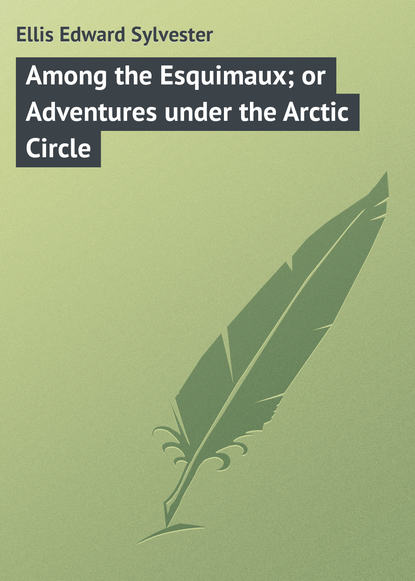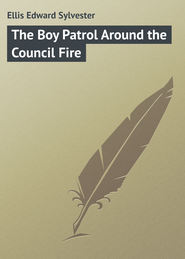По всем вопросам обращайтесь на: info@litportal.ru
(©) 2003-2024.
✖
Among the Esquimaux; or Adventures under the Arctic Circle
Настройки чтения
Размер шрифта
Высота строк
Поля
It was trying to the nerves of so brave a lad as he to observe a huge wave rushing like a courser straight toward them and looking as if nothing could save the boat from swamping; but, under the consummate handling of its owner, it arose to meet the wall of water and rode it easily. Then, as it plunged into the trough on the other side, it seemed as if about to dive into the depths of the sea, but immediately arose again with inimitable grace and readiness.
Then, perhaps, would follow a short distance of comparatively smooth water, quickly succeeded by the plunging and rising as before.
All at once the surface became smooth. Before Rob could guess its meaning something grated against the front of the kayak and slid along the side, followed by another and another. The native slowed his paddling and pushed on with extreme care.
He had entered a field of floating ice, through which it was necessary to force his way with all caution. This was proven by the many turns he made, and it was then that his skill showed in a more striking light than before.
He sat facing the prow and was obliged to look over the head of Rob and along each side of him. His quick eye took in the size and contour of the drift ice, and, hardly checking his own progress, he shot to the right, then to the left, turning so quickly that the bodies of his passengers swayed under the sudden impulse, but all the time he continued his advance, apparently with undiminished speed.
Meanwhile Jack Cosgrove, from his seat at the rear, was looking still farther ahead in the effort to gain sight of the welcome land, which never was so dear to him as when on the iceberg. Once he fancied he caught the twinkle of a light so low down that it was on shore, but it vanished quickly and he believed he was mistaken.
It was not long, however, before his penetrating vision discovered that for which he was yearning. The unmistakable outline of the coast arose to view, rising gradually from the edge of the water until lost in the gloom beyond. It was white with snow, as a matter of course, the depth probably being several feet. The sight of any considerable portion of Greenland free of its snowy mantle would be a sight, indeed.
The floating ice continued all the way to land, and the closer the latter was approached the more difficult became the progress. But the native was equal to the task. He had been through it too often to hesitate more than a few seconds when some larger obstacle than usual interposed across his path. It was very near land that the greatest peril of all was encountered. The kayak glided over a cake of ice, the Esquimau believing it would pass readily underneath the craft and out beyond the stern, but its buoyancy was greater than he supposed, and it swayed the boat with such force that it came within a hair of capsizing.
"All right!" he called, cheerily, righting the craft with several quick, powerful strokes of his paddle. Then he shot between two other enormous cakes, wedged his way through a narrow passage, and the prow crunched into the snow that came down to the water's edge.
"Here we are, and thank the Lord!" called out Rob, leaping with a single bound upon the solid earth; "I feel like giving three cheers, for if ever Providence favored a lot of scamps, we are the ones."
Fred followed as the kayak turned sideways, so as to permit all to step out, but Jack paused, opposite the native, and peered into his face. Something in the Esquimau's voice struck him as familiar.
"What's your name?" he asked, still scrutinizing him as closely as he could in the gloom.
"Docak," was the reply.
CHAPTER XVII
DOCAK AND HIS HOME
"By the great horned spoon, I suspected it! Docak, I'm mighty glad to see you; I'm Jack Cosgrove, and put it there!"
The native was not so demonstrative as his English friend, but he certainly was as delighted and surprised to meet him in this extraordinary manner as was the sailor to meet him.
They shook hands heartily, and Docak indulged in his peculiar laugh, which was accompanied by little, if any noise, but was indicative of genuine pleasure.
The reader will recall that this was the second time Docak had rescued Jack Cosgrove, the other instance having occurred a number of years before, when Captain McAlpine's ship was destroyed by collision with an iceberg.
"You're my guardian angel!" was the exclamation of the happy sailor; "I might have known that if anybody was to save us you was the chap to do it. Come up here, boys, and shake hands with Docak ag'in, for he's one of the best fellows living."
Rob and Fred were only too glad to do as invited, and cordial relations were at once established.
"Is your home where it was when I was here last?" Jack asked.
"Yes, off dere," replied Docak, turning about and pointing inland; "not far – soon get dere."
Jack gave a low whistle expressive of astonishment.
"Now, lads," he said, addressing the youths, "I rather think you'll own that Jack Cosgrove knows a thing or two about icebergs."
"I think Fred and I have also learned something, but what are you driving at?"
"We're well up toward Davis Strait, and there's more than a hundred miles of Greenland coast to the south of us. That old berg has struck a bee line for the North Pole, but it won't reach there, eh, Docak?"
"No; soon turn around – go back."
"Now, isn't that one of the strangest things you ever heard of, lads? The place where the 'Mary Jane' went down, afore that berg, three years ago, was mighty nigh the very spot where Docak found us. I remember he brought us ashore in his kayak – "
"Dis same boat," interrupted the native with a grin, perceptible in the twilight.
"There you are, and, if he keeps on, I'll begin to think that one of you chaps is Captain McAlpine himself, and the other Bill Hardin, who was saved with us."
"It is a most remarkable coincidence," said Fred, and Rob added that he had never read or heard anything like it.
But it occurred to Docak that he was not acting the part of hospitable host, by keeping his friends standing on the edge of the sea, while the reminiscences went on. He stooped and drew his boat far up the bank. The tide was at its height, so there was no fear of its playing the trick our friends had suffered. Then he turned about and started inland, the others following in Indian file.
He was treading a path, a foot or more deep in the snow, and worn as hard as a rock. The ascent was gentle, and a hundred yards from the shore he arrived at the entrance to his home, where a surprise awaited the boys.
When seen for the first time the hut of the Esquimaux suggest the sod houses common on the Western plains of our country, except that the homes of the far North are entered by means of a burrow. Where such frightful cold reigns for months every year the first consideration with the native is to secure protection against it; everything is sacrificed to that.
The walls are of alternate layers of stone and sod, and are about three feet in thickness. The highest clear space within is from four to five feet. The building contains an entry-way, a kitchen, and a living room. The entry is four or five yards in length, two feet or less wide, and no more than a yard in height. It will thus be seen that even a small boy would have to stoop to pass through it, while the interior of the hut itself will not allow a full-grown Esquimau to stand erect. To this fact may be attributed in some degree the stoop shoulders so common among the men.
Half-way between the beginning of the entry and the main rooms was an opening leading to the kitchen. This was small, shaped like a bee-hive, and with a hole at the apex for the escape of the smoke. The floor was bare ground, the hearth consisting of a number of stones placed close together, on which the iron kettles sat, while the fire of driftwood burned beneath. The height of the kitchen is less than that of the main room, so that only the women can stand erect in the highest portion.
When the weather is very severe the cooking is done in the main room, by means of the big oil-lamp, while the thick walls and the heavy furs of the inmates enable them to laugh at the raging blizzard outside.
It was along such a passage as the one described that Docak led the way, followed by Jack Cosgrove, Rob, and Fred, each trailing his rifle, and happy beyond measure that everything with them had turned out so well.
The main room into which the little party entered was about four yards square. It had a board floor and a ceiling – luxuries not generally found in the native homes except in the settlements. The walls were furred off and ceiled, and the spaces closely stuffed with moss. The wall on the right of the main room had a single window with twelve panes of glass.
The main room was the most interesting part of the structure. Along the front of the window ran a wooden bench, near the end of which, toward the entrance, stood a Danish stove. In the corner beyond the other end of the bench was a table. To the left of that was the lamp-stand, directly opposite to which on the other side of the room was a second and shorter bench.
The whole left-hand side of the room, as you entered, consisted of a platform, about six feet long. It was elevated a foot above the floor, the side next to the wall being a few inches higher. At night it was covered with feather beds, which are rolled back during the day, so that the front may be used for other purposes. The lamp used in the Esquimau houses is simply a large, green stone, with a hollow scooped in the top. This contains seal oil, a piece of moss serving as a wick.
It may be well to tell you something in this place about the dress of the Esquimaux, referring now to those who live near the settlements, most of whom are of mixed blood. In the interior, and, along the east coast of Greenland, are met the wild natives, who are muffled in the thickest furs, and bear little resemblance to the class to which Docak and his acquaintances belonged.
These men wore jackets, trousers, moccasins, and generally undershirts, drawers, and socks. The rule is for them to go bareheaded, though a hat or cap is frequently seen. The clothing, except the moccasins, is made from woolen or cotton stuff, bought off the Danish Governor.
The jacket is of gingham, with sleeves and a hood that can be drawn over the head, and fitted in place by drawing and tying a string that passes under the chin. When venturing out in his kayak, or in severe weather, Docak, like most of his friends, wore a jacket and hood combined. This was of sealskin, with the leather side out. The trousers are constructed of the same material with the hair out. Sometimes they are lined with sealskin, with the hair in.
The moccasins are well-shaped sealskin boots, reaching nearly to the knees. When the socks are not woolen, the hair is turned toward the skin. The mittens are of seal leather, with no hair on either side, and are much inferior to many of our own country, for purposes of warmth and comfort.
The Esquimau women are shorter of stature than the men, and walk with short, mincing steps, showing a stoop similar to their husbands. They have small hands and feet, with faces that any one would pronounce good looking. They comb their hair to an apex, which, if the woman is married, is tied with a blue ribbon; if a widow, with black; and if a maiden, with green.
The females generally wear collars of beads, with lace-work patterns and vivid colors. The waist is generally of woolen stuff, and here the same fondness for bright colors displays itself. It has no buttons, and is donned and doffed by passing over the head, and is fastened at the waist with a belt. Then come a pair of short trousers of sealskin, which are tastefully ornamented. Below these are the long-legged moccasins, also ornamented by the deft handiwork of the native owners. The dress of the children is the same as the parents.
CHAPTER XVIII
A NEW EXPEDITION











